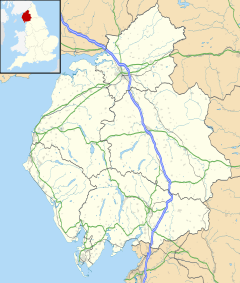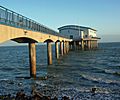Roa Island facts for kids
Quick facts for kids Roa Island |
|
|---|---|
| District |
|
| Shire county | |
| Region | |
| Country | England |
| Sovereign state | United Kingdom |
| Postcode district | LA13 |
| Dialling code | 01229 |
| Police | Cumbria |
| Fire | Cumbria |
| Ambulance | North West |
| EU Parliament | North West England |
| UK Parliament |
|
Roa Island is a small island located in Cumbria, in the north-west of England. It sits just south of the village of Rampside, at the very tip of the Furness Peninsula. It's one of the many Islands of Furness and covers an area of about three hectares (that's like three football fields!).
Even though it's small, about 100 people live on Roa Island. This makes it one of the most populated islands in England. For local government, it's part of the Borough of Barrow-in-Furness.
Contents
Roa Island's History
Until 1847, Roa Island was a real island! You could only reach it by boat or by walking across the sand when the tide was low.
Building the Causeway
In 1840, a banker from London named John Abel Smith bought Roa Island. He had a big idea: to build a path connecting the island to the mainland. This path, called a causeway, was finished in 1846.
He also built a long pier, 810 feet (247 meters) long, called Piel Pier. From this pier, steamboats would sail to Fleetwood. A railway line was built on the causeway, connecting the pier to Kirkby via Furness Abbey. At first, the railway only carried goods, but passenger trains started running on August 24, 1846.
Railway Changes
Over the years, there were some disagreements between John Abel Smith and the Furness Railway company. Eventually, in 1852, the railway agreed to buy the entire Roa Island property.
However, before the deal was done, a big storm badly damaged the pier. This allowed the railway company to buy all the rights and property for a much lower price. The Piel Pier was taken down in 1891 because the water around it became too shallow. The railway continued to be used until July 1936.
Today, you won't see much of the old railway. But many of the stones that make up the sides of the causeway were actually square stone sleepers from the railway tracks! Now, a road connects Roa Island to Rampside, following the path where the railway used to be.
Roa Island Today
Roa Island is a small community with about 100 residents. Despite its size, it has several interesting places.
Local Attractions
- Yacht Club: A place for people who love sailing and boats.
- Former Hotels: The Roa Island Hotel was built in 1849. It was first called the Pier Hotel. Another building, Villa Marina, was once a holiday home for a famous industrialist, H.W. Schneider. It has also been a science lab and an army building during World War II. Today, it is a hotel. You can see seven old cannons on its lawn, pointing out to sea.
- Cafe: A place to grab a bite to eat. You can also ask about the ferry to Piel Island here.
- Historic Buildings:
- Trinity Terrace: A row of houses built for ten special pilots from Trinity House. These pilots helped guide ships safely.
- The Watch Tower: This building was built in 1847 and used to be a Customs and Excise House, where officials checked goods coming in and out.
Lifeboat Station
Roa Island is also home to a very important RNLI lifeboat station. This station helps rescue people in Morecambe Bay and the Irish Sea. It was set up in 1864 and has recently been completely rebuilt and made bigger.
Some local people feel that Roa Island's potential for tourism isn't promoted enough. They believe it's a great place to visit, but not many people know about it.
Images for kids






